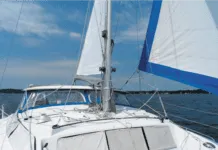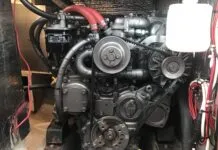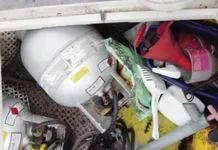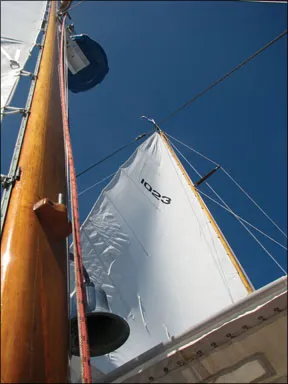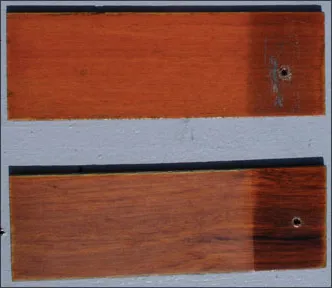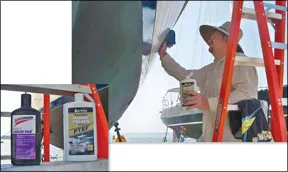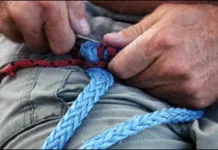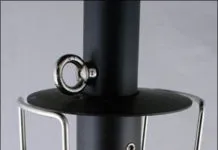Mailport: 12/09
I have a Pearson Ensign 1962 now at a slip in New Rochelle, N.Y. This season marked the first time we had the luxury of keeping our boat at a slip. In order to maneuver through the marinas byways without worrying, I bought a 24-volt Minn Kota outboard (80 pounds of thrust) and two 12-volt batteries, which I hook up in series. Not only am I able to stop start, turn, etc., in the marina, but-to my surprise-in the calm sound water, I can nip along at about 3-4 mph with myself, two crew, and the 3,000-pound boat. The result is that Ive only used my 5-horsepower Mercury outboard once this year. My electric outboard doesn't stall; it has variable speed like no ones business; reverses with relative ease, and is less expensive-though more cluttered-than the self-contained electric outboards you recently reviewed. Am I part of a growing trend or just weird? If the former then it might be worthwhile testing electric outboards for boats my size (22.5 feet) and commenting on their applicability.
Mailport: 11/09
To keep from being pulled under in a collision between a tanker and my sailboat, I "pulled the ripcord" to release the snap shackle on my Standard West Marine Safety Tether . The tether release lanyard was outfitted with a series of balls. (See bottom photo at right.) I had rehearsed reaching for and feeling the release toggle many times so it would come naturally in an emergency. The balls have a distinct feel. There was nothing on my PFD or foul-weather jacket that resembled them. The replacement tether I bought from West Marine (ISAF Specification Safety Tether, No. 9553504) has a new toggle on the snap-shackle release lanyard that consists of an open triangle of plastic. This is dangerous, in my opinion! In my first few hours of using the new tether, in moderate sea conditions, I managed to snag the triangular loop on something and release the snap shackle. I am now replacing all triangular loop pulls with bead pulls that I have crafted myself.
Testers Take Tacktick and Nexus Wind Instruments for a Spin
Practical Sailor testers compared Tackticks improved Race Master system to the Nexus Start Pack 3, a hybrid wired/wireless system. The Tacktick Micronet wireless wind instrument, a compact system featuring wireless display and a masthead sensor, has a strong following among racers. It has proven to be a good choice for those sailors serious about improving race performance as it has many options for tracking performance on the course in real time. Its ability to work with a 12-volt system makes it a good choice for small boats. The versatile, expandable Nexus hybrid has an impressive and intuitive interface and a graphic analog wind representation. It provides all of the basic functions a cruiser or racer uses most, and testers found the analog wind display appealing.
Shorepower Cop
Billed as the worlds only shorepower corrosion detector with reverse polarity indicator by West Marine, Marincos new Galvan-Alert attaches to your existing 30-amp shorepower inlet and power cord and monitors galvanic and stray current corrosion flowing through the green ground wire ground of your shorepower system. Appearance-wise, the GalvanAlert is similar to a miniature Marinco power cord. It is well constructed and utilizes the same plugs, connectors, and locking rings that are familiar to most every boater with an AC shorepower cord. The GalvanAlert has four LED indicators-a green LED to indicate power, a red LED indicating reverse polarity, and two other LEDs to show medium (green) and high (red) galvanic corrosion activity.
Mailport: 10/09
The way I was taught towing Lightnings to LIS regattas, you used a towing hitch around the mast for the line ahead and a similar hitch around the mast for the line to the boat astern. A towing hitch (two wraps around the mast, a wrap around the standing part, back the other way around the mast and two half-hitches around the standing part) could be cast off under tension or even eased under way to place the boat astern on the second wave. Bowlines, we were told, presented a danger of catching a finger in the knot if the towline came under tension while you were catching on or casting off the tow.Recently, a sailing director setting up a tow of Ideal 18s, directed us to tie a bowline with a generous bight around the mast and then to take up the towline from the boat astern and tie a bowline through the bight around the mast. He asserted that this would produce no pressure on the mast at all, as the forward pressure of the tow would be offset by the aft pressure of the boats behind. Can you advise on the best method for securing sailboats in a tow? And what is the optimal distance between boats in a tow?
PS Advisor: The Curse of the Pox
Boat maintenance master Don Casey, on the BoatUS website (www.boatus.com), suggests cleaning the surface using a mild abrasive like Bar Keeper’s Friend (www.barkeepersfriend.com) and fine bronze wool, and then sealing the surface with a wax. Sparmaker Seldén Mast recommends applying Woody Wax (www.woody-wax.com) using bronze wool to seal the surface and remove the pox. Casey cautions against using a polish on aluminum as some are so abrasive they will peel away the anodizing. We’ve had success with Mothers (www.mothers.com) and Prism Polish (www.mppros.com), but we do not recommend using the Mothers with the Powerball on aluminum. Be sure to read the label on any polish before using it; some advise against use on anodized aluminum.
Mailport: 09/09
As a prior owner of a Charley Morgan yacht, I greatly appreciated your article on the Morgan 30. I could relate to the difficulties of that boat, having had to replace a broken centerboard pennant, replace the Palmer M60 with a Yanmar diesel, install a second battery, and live with fairly primitive belowdecks amenities. Yet for all those issues, I loved the boat. The centerboard could be used to move the lateral resistance forward or back, so it was possible to get the boat to balance perfectly and track with barely a finger on the tiller. Ive sailed the Chesapeake Bay for 39 years and have owned a Morgan, Bristol, and Pearson. Of the three, the Morgan was the most fun to sail.
Whos Lurking Behind Those Blog Posts?
In the magazine business, our calendar is set forward several months, so while summer sailing is reaching its peak, were stowing away editorial acorns for winter. Articles on cold-weather sea boots and heavy-weather sailing are on the horizon, along with a two-part series on inverter-chargers. The upcoming story that bothers me most, however, is a long-overdue update on maritime websites. Its something of a sore subject because were undergoing the painful revamping of our own website (a process akin to rebuilding your diesel engine in the middle of your galley), but also because the deeper we dig into the world of websites, blogs, and reader forums, the more trouble we find.
Gripping Hitches for Loaded Lines
Testers evaluated five different knots to determine which would be the ideal for holding a tensioned line. Testers considered ease of tying and untying, ease of learning and recall, and holding power with various types of line. The old standard rolling hitch was pitted against the modified rolling hitch, icicle hitch, gripper hitch, and sailors hitch.
A Look at the Latest Generation of Genoa Furlers
To get an idea of whats on the market and see how the newer products fare against the simpler, tried and true furling systems, Practical Sailor rounded up 11 new headsail furlers suited for 30- to 35-foot sailboats. This, the first of a two-part report on the evaluation, focuses on the seven products that use a head-swivel design and range in cost from $950 to $3,200. (The report of integral systems will follow in an upcoming issue.) The following furlers were reviewed: Facnor LX 130, Harken MkIV and Cruising 1, Profurl LCI32, Schaefer 2100, Furlex 200S (Selden Mast), and US Spars (Z-Spar) Z-780.













